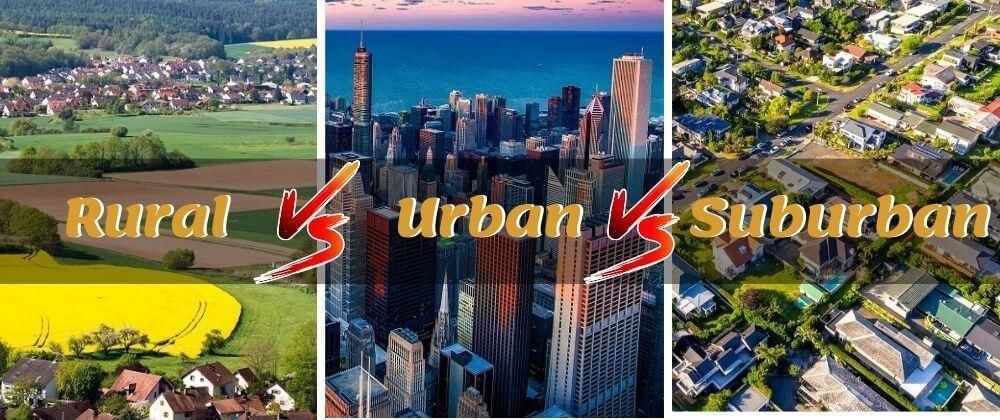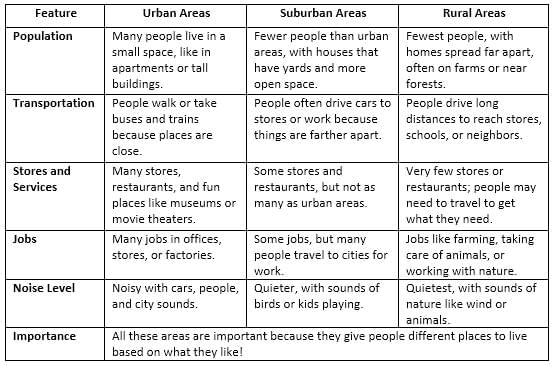Grade 3 Exam > Grade 3 Notes > Social Studies for Grade 3 > Chapter Notes: Human geography
Human geography Chapter Notes | Social Studies for Grade 3 PDF Download
| Table of contents |

|
| Introduction |

|
| Major U.S. Cities |

|
| Identify Urban, Suburban, and Rural Areas |

|
| Compare Urban, Suburban, and Rural Areas |

|
Introduction
Human geography is all about learning how people live in different places. In this chapter, we will explore major cities in the United States, understand what urban, suburban, and rural areas are, and see how these places are different from each other. This helps us know more about the communities where people live, work, and play!
Major U.S. Cities
A city is a place where many people live close together.
- New York City is one of the biggest cities in the United States. It has tall buildings called skyscrapers and many people from all over the world.
- Los Angeles is a city in California known for its sunny weather and places where movies are made, like Hollywood.
- Chicago is a city in Illinois with big parks, museums, and a lake called Lake Michigan nearby.
- Houston is a city in Texas where many people work in jobs related to space, like at NASA.
- Washington, D.C. is the capital city of the United States. The President lives here in the White House, and important government buildings are here too.
- Miami is a city in Florida with beaches and warm weather, where many people speak Spanish.
- Atlanta is a city in Georgia with a big airport and places where important history about equal rights happened.
- Boston is a city in Massachusetts with old buildings and schools, and it’s famous for the American Revolution.
- San Francisco is a city in California with a famous bridge called the Golden Gate Bridge.
- Seattle is a city in Washington known for its coffee shops and a tall tower called the Space Needle.
Identify Urban, Suburban, and Rural Areas

- An urban area is a city where many people live close together in apartments or houses.
- Urban areas have tall buildings, busy streets, and lots of stores, schools, and offices.
- A suburban area is near a city but has more space, like neighborhoods with houses, yards, and parks.
- Suburban areas are quieter than cities and have fewer tall buildings.
- A rural area is far from cities and has lots of open land, like farms, forests, or fields.
- In rural areas, houses are farther apart, and there are fewer stores and schools.
- Urban areas are crowded with people and buildings, while suburban areas have more space, and rural areas have the most open land.
Compare Urban, Suburban, and Rural Areas

The document Human geography Chapter Notes | Social Studies for Grade 3 is a part of the Grade 3 Course Social Studies for Grade 3.
All you need of Grade 3 at this link: Grade 3
FAQs on Human geography Chapter Notes - Social Studies for Grade 3
| 1. What are the main differences between urban, suburban, and rural areas? |  |
Ans. Urban areas are characterized by high population density and vast human-made structures, such as cities. Suburban areas are residential regions situated on the outskirts of urban areas, typically featuring single-family homes and some commercial properties. Rural areas have low population density and are often associated with agriculture and open spaces.
| 2. Can you give examples of major U.S. cities that are considered urban? |  |
Ans. Yes, major U.S. cities that are considered urban include New York City, Los Angeles, Chicago, and Houston. These cities have large populations, extensive infrastructure, and diverse economic activities.
| 3. How do urban areas impact the environment compared to rural areas? |  |
Ans. Urban areas tend to have a greater impact on the environment due to higher levels of pollution, waste generation, and resource consumption. In contrast, rural areas often have less pollution and more green spaces, but they can still face environmental challenges related to agriculture and land use.
| 4. What are some benefits of living in suburban areas? |  |
Ans. Living in suburban areas offers several benefits, including quieter neighborhoods, more space for families, and access to schools and parks. Suburbs often provide a balance between the conveniences of urban life and the tranquility of rural living.
| 5. How do people in urban areas typically commute compared to those in suburban and rural areas? |  |
Ans. People in urban areas often use public transportation, such as buses and subways, due to higher population density and traffic congestion. In suburban areas, residents may rely more on personal vehicles to commute, while those in rural areas typically have longer commutes and fewer public transportation options.
Related Searches



















